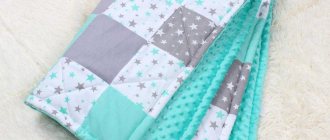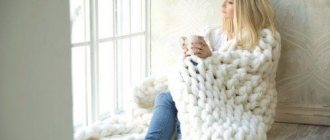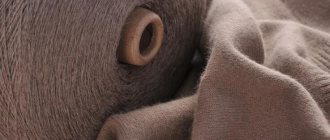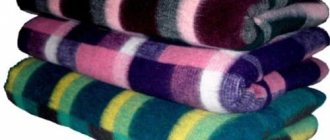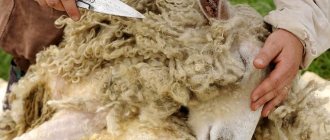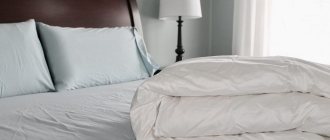Description and characteristics of a merino blanket
Australian Merinos are a special breed of sheep renowned for their wool. Merino fleece sets them apart from other sheep breeds. Long merino fibers are ultra-fine and at the same time very durable. Soft and silky to the touch, they retain heat well. Due to these qualities, merino fibers have become very popular in the manufacture of blankets.
Benefits of merino blankets
Buyers appreciated all the benefits of merino bedspreads.
- Hygroscopicity. Merino wool has a valuable property: it absorbs moisture well. Under such cover a person does not feel sweaty: droplets of sweat are absorbed by the wool.
- Ventilation and thermoregulation. The special twisting of the threads leads to the formation of air layers in the wool base. This way natural ventilation occurs. At the same time, a constant body temperature is maintained.
- Practicality. The products remain clean even with daily use for a long time. This is due to the properties of the fibers: twisted into an elastic spring, they repel dirty particles and prevent them from accumulating. Therefore, it is enough to shake the blanket to keep it clean.
Reference! Natural fibers from elite sheep, absorbing up to 30% of their own weight, remain dry.
The smell of sweat also does not manage to penetrate the structure, so things do not acquire an unpleasant odor. Elite fibers retain their high-quality appearance for a long time, do not lose their shape, and the blanket filling does not crumple.
This is interesting: Togas brand bed linen: description of family collections from Greece
Why is merino wool valuable?
Merinos are a special breed of sheep. Cattle breeders in Spain bred it seven centuries ago, but for five centuries they were not allowed to breed it in other places. Exporting these sheep was punishable by death. When the British defeated Spain in the 18th century, several sheep were exported to other European countries, including Australia - today it is the largest producer of merino wool. And it is valued due to such magnificent properties:
- Fine-fleece. Merino wool is very fine. Human hair is several times thicker than hers. Merino products are soft, but do not look bulky, but elegant.
- Heat retention and hygroscopicity. Merino warms well, absorbs moisture vapor, while remaining dry.
- Ability to repel odors. Wool does not absorb odors, including sweat.
- Resistant to dirt. Merino wool fibers have curls that look like springs. Therefore, dirt does not penetrate inside and is easily removed from the surface.
Merino wool is also antibacterial due to the creatine in its composition, and is environmentally friendly. Our store has a wide range of men's and women's clothing with such valuable properties. We offer you thermal underwear, leggings, long johns, robes, and merino sweatshirts. With such clothes, you and your family will forget about the cold, allergies and other unpleasant phenomena. And knowing how to wash things made of merino wool, you will retain their shape and sophisticated appearance for a long time!
Complete your wardrobe with high-quality merino clothing from the Doctor TM store.
Types and sizes
Merino wool is unique in its characteristics, therefore it is used in the production of various sleep products: blankets, quilts, blankets with open wool, bedspreads.
Blankets with open wool are especially popular. A blanket without a cover is in better contact with the body, which means the healing effect of merino wool is better. Such blankets are made using a weaving method in which the wool undergoes a minimal amount of processing and retains its healing properties. Opening blankets are light and thin, but at the same time warm.
There are varieties of such products:
- with open fur on both sides;
- with a sewn cover on one side.
Such products help improve blood microcirculation, improve metabolism, and protect against electromagnetic influence. Moreover, the absence of a cover ensures self-ventilation and ventilation of the product, which allows you to increase its service life.
Blanket sizes:
- 80x100 cm – for newborns;
- 110x140 cm – children’s;
- 150x200 cm – for a one-and-a-half bed;
- 180x210 cm – double;
- 200x220 cm – “euro” size;
- 240x260 cm – king size, maximum king size blanket.
The unique composition and properties of Australian merino wool have determined the use of this raw material in the production of blankets, rugs, and bedspreads for all age categories.
What are the benefits of merino yarn?
Wool is unique in its ability to maintain body temperature, preventing you from freezing in winter and overheating in summer. Delicate fleece, like silk, pleasant to the touch, has a positive effect on a person’s well-being:
- normalizes blood pressure;
- reduces headaches, back and joint pain;
- relieves muscle spasms and relaxes the nervous system;
- improves blood flow, facilitating the functioning of the cardiovascular system;
- relieves stress, giving joy and peace.
Warmth and comfort
Is it machine washable?
Taking good care of the product means delicate hand washing using conditioner. Careful flat drying and light ironing with a warm iron are required.
Full relax
If a triangle is drawn on the product label, then machine washing is allowed, but it is worth considering a delicate cycle and a water temperature of no more than 30 ° C. A lot depends on the composition of the raw materials from which the blanket is made.
Note! It is possible to add sheep wool fibers from other breeds, making the fleece more resistant to washing.
The manufacturer depicts a bowl of water on the label if the product can be hand washed. In this case, it is possible to use gentle products that exclude the presence of chlorine for bleaching.
You might be interested in this. Detailed description of Mongolian cashmere from the Gobi factory
The absence of appropriate signs indicates that you should limit yourself to dry cleaning the rug without using water. Increased attention to an expensive product that competes with alpaca products will extend its service life.
Plaid after washing
How to properly wash a merino wool blanket
It is not always possible to get rid of dirt with just dry cleaning. Shaking and periodically drying with fresh air ventilation will eliminate the need to wash the blanket.
It should be noted that if washing cannot be avoided, then the correct actions will keep the fibers in their original form. Using smooth movements without much friction, wash the blanket in warm, comfortable water with the addition of conditioner.
Note! Prolonged soaking and washing in hot water can lead to shrinkage of the product, and not always symmetrically. A large knit merino blanket requires a special approach to cleaning it from dirt.
Merino wool blanket
Frequent washing is not recommended by the manufacturer. This is justified by the fact that knitted wool is even more delicate than sheep's down, which does not require periodic washing and cleaning. Stains can be removed with ordinary white laundry soap, rinsing off the residue with warm water.
Is it possible to wring out and how to dry?
The product should not be twisted, like most knitted wool items. By squeezing a blanket, you can disrupt the structure of the fibers, so it is recommended to leave the product on a special rack or place it at the bottom of a basin so that the water can drain naturally. When the excess moisture has drained, you need to lay out the blanket, leveling it over the entire area.
Factory plaid
Proper drying of the blanket in a horizontal position will ensure that it retains its shape. Excess moisture can be collected with a terry towel. The use of hair dryers and heaters is prohibited. Drying in the sun is not recommended. There is no need to iron the blanket.
Handwash
Instructions on how to wash merino wool by hand:
- Prepare suitable water and pour washing gel into it, foam. Temperature - no more than 40°, preferably 30-35°. If the merino item is very bulky, take care of a large container - this could be the bathroom.
- Submerge the item and leave it in the liquid for 5 minutes or less.
- Slowly rinse the product in water at the same temperature. You also need to rinse carefully 2-3 times under a gentle stream. The draining water should be clean and free of soap.
- Squeeze out excess water without twisting the item.
Sizes and prices
The appearance on the market in 2015 marked the beginning of sales of merino blankets in the Russian markets. Making bedspreads by hand, from children's bedspreads measuring 70x70cm to double bedspreads measuring 200x210cm, brought quick success.
Therapeutic blanket
Prices are determined by thread consumption and volume of work and range from 2,900 to 12,900 rubles.* Blankets with large knitting are made to order. Finished products of non-standard sizes can reach a cost of up to 141 thousand rubles.
Blanket as a gift
The main companies that produce blankets in Europe are OHHIO, DollyWool, ModernWool.
You might be interested in Description of gauze: types and uses of fabric
| OHHIO | DollyWool | ModernWool | |
| Blanket sizes | from 40×60 cm to 152×203 cm | from 70×70 cm to 200×210 cm | from 90×120 cm to 230×260 cm |
| Number of colors | 14 | 14 | 5 |
| Prices | from 12,594 to 40,500 rub. | from 2900 to 12,900 rub. | from 31,000 to 141,000 rubles. |
Coat for baby
You can purchase a blanket:
- as an expensive gift for a wedding or anniversary;
- for home use:
- for relaxing in the car or on a picnic;
- as a shawl on the shoulders for work;
- as a healing blanket;
- for decorating a living room or bedroom.
Merino blanket
Expensive natural material is difficult to care for, but brings a lot of pleasant sensations to the owner. The remarkable qualities of a blanket made from the finest pile are preserved for several decades if the product is treated with care.
Handmade by a master
*Prices are as of June 2021.
This is interesting: Furniture covers: types, types, materials, design
How to wash merino wool items
Various products are made from it - small and voluminous, long and short. The care process also depends on this, so we’ll tell you about the most popular items made from merino wool: how to wash it correctly.
Thermal underwear
How to wash merino wool thermal underwear:
- At t 35°.
- Better with your hands. If you want to machine wash, skip the spin and dry cycle.
You can iron thermal underwear, but set the iron to the minimum temperature. All other recommendations are the same. Do not forget to place slightly damp gauze or thin cloth between the iron and the item.
We have men's and women's thermal underwear, single-layer and double-layer (merino wool and coffee fibers). You can purchase a set or separately a sweatshirt with long johns and leggings. We sell environmentally friendly materials and constantly update our range.
Sweater
How to wash a merino wool sweater:
- Manually.
- At t 30°.
- In soft water. Pre-boiling helps soften it. Don't forget to cool the water to the desired temperature.
If it is not possible to wash the sweater by hand, you can use a machine, but place the item in a special bag. Select the correct mode, but without spinning and drying. The rest of the advice is the same.
If possible, take your clothes to a dry cleaner, where they can dry clean the item.
Plaid
The preferred cleaning method is dry cleaning.
How to wash a merino blanket at home:
- Hands in plenty of water.
- At t 38°.
- Okay, but wash the item carefully so that the detergent and water act on the entire thickness of the fibers.
Bobbin merino
Bobbin yarn can withstand load better and is not deformed when knitted by machine. But such material requires a special approach when washing, because it can be impregnated with special compounds to give the thread special mechanical properties.
When knitting with such yarn, measure the sample before and after bath and laundry procedures.
Tips on how to wash bobbin merino:
- Before washing, steam the product to remove the wax from the yarn.
- Wash at 30°.
- Do not twist, there should be no friction.
- You can soak for 5 minutes, periodically squeezing the knitting sample with your hands.
- Dry according to the general rules for merino.
- A sample or a product knitted from new bobbin yarn can be washed twice for the first time.
After washing, bobbin merino will fluff up, increase in size, and remove wax and other substances. Samples should be washed in the same way as finished products.
Merino with acrylic
Other fibers are rarely added to merino wool, not to improve quality (merino quality is impeccable), but to reduce cost. Acrylic is a polymer fiber. Even the addition of 20% acrylic significantly reduces the cost of the yarn produced, and therefore the finished product, and also makes it less difficult to care for.
When washing merino with acrylic, the temperature should also be 30-40°. You can soak the item for 10 minutes. The recommendations for the process of washing, drying and ironing are the same, but you can wash a merino product with acrylic more often and it will keep its shape longer and better. Much depends on how much acrylic is in the composition.
Varieties of merino wool blankets
The industry today offers a large selection of merino bedspreads. They vary in weight, size, and design.
Lightweight, lightweight, standard merino wool blankets
The weight of the product depends on how tightly woven the fibers from which it is made are. There are 3 types of products based on weight.
- Lungs. The threads in these bedspreads have the lowest density. 1 m² of material weighs 150 g.
- Lightweight. In their production, medium thread density is used. As a result, 1 m² weighs twice as much as light ones - 300 g.
- Standard. The tightest threads are woven in standard blankets. That's why they weigh more than the others. Weight 1 m² - 400 g.
Reference! Light bedspreads are best used in warm weather. Lightweight ones can be covered throughout the year, especially if the bed is located in a room that is drafty or has high humidity. Standard ones are designed for the lowest temperatures.
Appearance and content
Products differ not only in weight. Their design also varies: with and without filler.
Merino blankets are produced in 2 types:
- with wool filling inside the case;
- without filler, made of woolen fabric.
Surface:
- Varieties with filling have covers made of satin or cotton.
- Unfilled varieties come in all wool or have merino fabric on one side. For the second side, natural (satin) or synthetic fiber is used.
It is believed that to achieve a healing effect, wool must have direct contact with the body.
Reference! The price of things depends on their type and the amount of elite fiber used. The least expensive are blankets with a cover with filling, the most expensive are products made entirely of wool.
Merino blanket sizes
Given the uniqueness of merino bedspreads and their use for a variety of purposes, manufacturers produce products in different sizes.
For children:
- Newborns and infants: 0.8 m x 1 m.
- Children under 10 years old: 1.1 m x 1.4 m.
For adults:
- Single bed: 1.5 m x 2 m.
- Double bed: 1.8 m x 2.1 m.
- European size: 2m x 2.2m.
- Maximum (“royal”) size: 2.4 m x 2.6 m.
Varieties
They are determined by two factors: mass with density and appearance.
Density and mass
There are three types of blankets:
- Lightweight with a density of 100-150 g/sq.m. m. Suitable for summer use.
- Universal lightweight ones with a density of 250-300 g/sq. m. Suitable for any time of year. They warm well in damp rooms with drafts.
- Standard 350-400 gsm. m. It is comfortable under them in winter in the north. Sometimes their density varies up to 800 g/sq.m. m.
The weight of the product increases in direct proportion to its density.
Appearance
According to this criterion, merino wool blankets are divided into three types:
- Quilted closed options. The fabric shell is filled with wool and quilted together. The wool layer can be thick or thin, there is a blanket for every season. Covers are made from wear-resistant natural or mixed materials - satin, cotton, calico, polycotton.
- Open wool blanket. On one side there is fabric (usually satin or synthetic), on the other there is wool. They are suitable for summer or off-season; in winter they can be cool.
- Pure wool blanket. Costs more than previous options. More comfortable and pleasant in appearance.
Quilted ones are the most common and inexpensive. They will last longer and suit most people.
Products may vary in density and aesthetic appearance.
Based on density, the following types can be distinguished:
- lightweight merino pile blanket, density 100-150 g/m2. m. Convenient for covering in warm weather;
- universal with a density of 250-300 g/m2. m. Will keep you warm in any weather;
- standard – 350-400 g/sq.m. m. They will keep you warm even in severe frosts; you can even find products with a density of up to 800 g/sq.m. m.
Based on their aesthetic appearance, products can also be divided into types:
- blankets covered with fabric on all sides, the wool is inside. The density may be different, the fabrics also selected are different;
- with an open wool side and a closed fabric side on the other. Lighter options for warm weather;
- completely wool, the cost is higher, but the appearance is more beautiful.
We invite you to familiarize yourself with the first launch of a Bosch washing machine
Advantages
Finished products made from merino wool have the following advantages:
- natural ingredients are hypoallergenic;
- During sleep, the body remains dry at a constantly maintained temperature, thanks to increased hygroscopic properties. Wool can absorb up to 1/3 of its own volume of moisture, while the fibers remain dry;
- natural material self-ventilates and allows the skin to breathe;
- The thermoregulation properties of the product are achieved thanks to the twisted structure of the fibers, which create air layers in the product;
- natural material does not absorb unpleasant odors, and the porous structure prevents the accumulation of dust and dirt;
- antiseptic properties and therapeutic effect (for diseases of the musculoskeletal system, colds, to stimulate metabolism) are provided due to the content of natural lanolin in the fibers;
- use of the highest quality raw materials from the withers of Australian Merino sheep;
- long service life of the product due to the elasticity of the fibers, which, after deformation, return to their original shape.
These unique characteristics of products made from merino sheep wool are responsible for their high cost.
How wool is made into fabrics
Sheep shearing to obtain raw materials is done manually, then goes through the following processing steps:
- sorting;
- wash;
- separation of fibers using a special machine;
- combing wool and obtaining roving (thread) on a machine.
Then follow the stages of weaving and processing the fabric, depending on the purpose of the raw material, including dyeing.
For standard fabrics, threads with a cross-sectional value from 15 to 22.6 microns are used in production. The finest merino fabric is made in Italy from fibers purchased in New Zealand, less than 12 microns thick, and is called “Gift of Kings”. This is a rare type of material, and its annual production is limited, and the cost of such fabric is comparable to the cost of a car. This is because they get very little of such fine fibers when shearing merino sheep - 2000 kg per year.
How to choose?
A merino wool blanket is not a cheap pleasure. Therefore, his choice must be approached responsibly, with knowledge of the matter. What factors should you consider when purchasing it:
- Fluctuations in indoor temperature depending on the season and weather.
- Features of your own body: whether you are “freezing” or like it when it’s cooler.
- Do you like thick or thin blankets?
- Do you sleep alone or together?
- Do you prefer the product with a case or not?
You should also pay attention to the following product features:
- How the blanket is sewn . There are 3 types of tailoring: parallel quilted, stitched with “squares” or the so-called karostep - patterned stitching. It is preferable to choose the 2nd or 3rd types.
- What is the cover made of (if any). It is recommended to opt for calico, satin or jacquard fabric. They are natural, breathable, quite durable, last a very long time, and are pleasant to the body.
- Information on the label. The following must be indicated: the manufacturing company, in which country it was produced, care recommendations, materials for making the cover and filler. The completely natural “filling” is accompanied by the NOMITE mark.
- Presence or absence of odor. It is worth paying attention to whether there is an admixture of “chemistry” in the aroma. It shouldn't exist.
- Workmanship. Good manufacturing companies carefully monitor the performance of their products and exclude defective goods with protruding threads and crooked stitching.
- The information on all product labels and tags must be completely identical.
Advantages and benefits
One of the most surprising and positive features of sheep's wool is its “three-dimensional” structure . Long downy fibers of wool, clinging to each other with their curls, form millions of air pockets. Thus forming an airy, soft, warm, elastic material that does not bunch up or form lumps.
Thanks to this structure, a product made from sheep wool has the following unique qualities:
- Effectively retains heat and maintains temperature balance due to the air between the wool fibers. It's neither hot nor cold under a sheepskin blanket.
- Absorbs moisture well , unlike synthetic products. At the same time, it remains dry and warm, as it easily evaporates the accumulated moisture.
- Sheepskin blankets are light and airy .
- Sheep wool is considered fireproof , since each wool contains water and is covered with a special cornea; its combustion requires a very high temperature than for products made from other natural fibers.
- It has an antistatic effect , does not accumulate dust and is not electrified.
- Due to the movement of air in the structure of the filler, self-cleaning from dust and sweat .
- Wool fibers are coated with a natural antiseptic (lanolin), which effectively destroys toxic substances contained in sweat and prevents unpleasant odors from being absorbed.
- The affordable price of the product is of no small importance . Unlike other natural fillers, sheep's wool is not as expensive. The double-sided woven blanket option is the most luxurious, but also considered the most expensive.
- A product made from sheep wool is considered hypoallergenic . Cases of allergies are very rare.
- The medicinal, healing properties are considered an undoubted advantage . The above-mentioned lanolin is used by pharmacists and cosmetologists to make antibacterial creams and ointments. Heating up overnight, microdoses of lanolin enter the human body and heal it. A blanket around the human body creates an aura of dry heat, which has a positive effect in the treatment of bronchitis, radiculitis, diseases of the joints and spine, muscle tissue relaxes, thereby restoring blood circulation, and normalizing heart rate and pulse. Blankets with exposed wool are believed to have the greatest healing effects.
How to wash a wool blanket by hand
First of all, many people are concerned about the question at what temperature wool products can be washed. The water for both machine and hand washing should not be higher than 30 degrees. To wash by hand, fill the bathtub with cool water and add wool washing gel or your own homemade product:
- For products made from sheep's wool, add a tablespoon of borax and 200-250 ml of liquid soap, then put the linen in the solution and leave for 6-8 hours;
- To wash a camel wool blanket, make a solution of laundry soap at the rate of 10 grams of soap per liter of water. Add the soap mixture to the water and stir. Place a blanket or blanket in the bath and leave for 10-30 minutes;
- When washing with wool gel or shampoo, dilute the product in water and place the product in the bath. If necessary, leave for a few minutes;
- To remove tough stains, add two tablespoons of turpentine to the water.
While soaking, periodically turn the canvas over, then apply a few light blows, lightly stretch the contaminated areas, but do not rub or squeeze the material!
Stains can be lightly scrubbed with a soft bristle brush. After washing, rinse the items thoroughly in cool water until the soap suds are completely washed off.
To prevent the blanket from losing its softness and elasticity, add a tablespoon of wine vinegar to the water during the last rinse. Lemon juice or a slice of lemon will help preserve or restore the color of the product and eliminate yellowness.
Add the product to clean water and leave the items in the solution for twenty minutes. Then rinse in clean water.
Who are Merinos?
Merinos are a very special, elite breed of sheep. It is believed that it was bred in Spain in the 12th century, however, after they were brought to Australia in the 18th century, sheep began to be bred almost exclusively there. The reason was the special Australian climate, favorable for these animals. Merino sheep differ from ordinary sheep in their small size; they are not kept for food. The main trump card of these cute creatures is their luxurious wool, from which they make things of amazing quality.
This is due to the fact that merino wool fibers are very light, weightless, thin, but at the same time they are durable and have a high density.
Care instructions
Caring for products made from merino fabric is simple:
- The fabric can only be washed by hand. The water temperature for washing is selected depending on the manufacturer’s recommendations and is no more than 60 degrees;
- Products can be cleaned using special products. They resort to this infrequently, since the material has dirt-repellent properties. Cleaning needs to be done by special services;
- You cannot wring out the products! Dry flat on a soft surface, for example, a towel, in a well-ventilated area;
- pillows, rugs and blankets are not washed. They need to be immersed in water with detergent for a few minutes, taken out, allowed to drain and laid out to dry without twisting;
- To restore the color of an old product, just keep it in water with lemon juice added to it.
How to properly wash a merino wool blanket?
According to many housewives, some types of dirt can be easily removed by dry cleaning. It is enough to gently shake the bedspread and walk over it with a soft brush. If you cannot avoid washing, it is important to do it correctly:
- first of all, you should carefully study the special label, where the manufacturer schematically displays the main recommendations for caring for a specific product;
- It is better to wash delicate items by hand using special cleaning products;
- You can use conditioner to maintain softness;
- the water temperature for washing should not be warmer than 30 degrees;
- There is no need to rub the bedspread too much so as not to destroy or deform the canvas.
After washing, the blanket must be dried properly. To do this, carefully remove excess water and leave the product in a horizontal position, away from heating appliances. Usually the bedspread is placed on a terry towel so that it absorbs excess moisture. Towels can be changed as needed. If you hang a wet blanket on a clothesline, this can cause the fabric to stretch greatly.
Is it machine washable?
Some types of wool yarn undergo special processing. This does not affect the properties of the material and the comfort of wear, but allows you to use machine wash without any particular harm to the product.
You should first carefully study the tag and make sure that in a particular case automatic washing is acceptable.
If the manufacturer does not prohibit washing the item in a machine, it is recommended to choose a delicate cycle and cool water, and use gentle detergents.
Choice
A series of warm blankets Magic Night filled with natural merino wool brand Nordtex
Things to consider before purchasing:
- the time of year for which the item is intended;
- how the body tolerates different temperatures, whether it likes coolness or warmth;
- comfortable under a thin blanket or like the security of a heavy one;
- it should be in a cover or with the wool facing out.
What to look for when purchasing:
- Case material (if available). The best options are natural jacquard, satin or calico. They are strong, durable, breathable, and pleasant to the touch.
- A blanket made from Australian merino wool must be marked with the source material.
- Presence of odor. Sheep wool has it, but it may not exist if all technologies are followed. There definitely shouldn’t be a chemical or unnatural smell. Even if the composition is completely natural, these may be the consequences of chemical processing that should not exist.
- A high-quality blanket, with or without a cover, does not have lint sticking out. You can get them from the inside with some effort. There should be no crooked stitching or protruding threads.
- Quilting options: parallel, squares or patterns. The last two are better.
- Weight and cost of the product. If it is light or costs up to two thousand rubles, it means there are synthetic impurities.
- The label of a good product indicates the density, weight, composition of the filler and cover, dimensions, and care tips.
- 100% natural merino filler is marked with the word NOMITE.
You should only buy a blanket for your child if it fits. There are different sizes, even for the smallest ones. If the child does not mind a heavy blanket, you should take a larger size. Children grow faster than the life of the blanket. But if you have allergies, it is better to go with the synthetic version.
Important
For the healing properties to be effective, contact between fur and skin is necessary. You will need a pure wool blanket without a cover or duvet cover.
Dimensions
The merino blanket has the following dimensions:
- for infants, newborns 80x80 cm or 80x100 cm;
- children under 10 years old 1.1x1.4 m;
- single bed 1.5x2 m;
- double bed 1.8x2.1 m;
- European version 2x2.2 m;
- king size 2.4 x 2.6 m.
These are commonly found sizes for merino blankets.
Expert recommendations
To ensure that the item continues to please you with its appearance and service, follow a number of easy-to-follow recommendations. More details:
- Do not soak the blanket for a long time - a quarter of an hour is enough.
- Make sure that air enters it from all sides. With heavy options, you can use a horizontal bar and spacers for the sides.
- It is better to add too little cleaning agent than to add too much.
Often, washing a wool blanket seems like a feat that not everyone is capable of. However, if you know how to tackle this matter correctly, then anything can be put in order even without resorting to the help of professional “cleaners”.
What to look for when choosing merino blankets
When choosing, the buyer must first determine exactly what product he needs.
It depends on your own preferences regarding temperature, as well as on who it is chosen for (children or adults), and in what season it is intended to be used. During the purchasing process, you need to carefully consider the item, paying attention to the following points. Label. It should contain all the information about the composition of the material (and the cover), the manufacturer, and the rules of care.
Workmanship. High quality is evident in every seam and line on the product. There should be no crooked or broken lines or protruding threads.
Smell. If the product has even a slight “chemical” smell, this should alert you. Such “aromas” indicate the presence of synthetics or chemical processing of fibers that is not allowed by traditional production.
Cover and sewing method. It is recommended to give preference to products that have cotton covers rather than synthetic ones, which are stitched with squares or patterns.
Rules that will help extend the life of a merino wool blanket
It is advisable to make holes in the storage bag so that the blanket “breathes”, this will make it last longer.
When airing outdoors, hang the product in the shade; under the sun's rays it will lose its brightness.
Rolling of wool cannot be avoided; when pellets appear, they can be carefully cut off with scissors; you should not pull them out with your hands, this will lead to the formation of new pellets.
A merino blanket can give comfort, warmth and coziness to its owner. And also improve his body. You need to make your purchase wisely, choosing only reliable manufacturers to get a quality product.
Drying merino wool
Prolonged exposure to water damages woolen items. Therefore, it is better to refuse washing in an automatic machine. An exception is made for small items. Knitted hats, socks, mittens, and thermal underwear are loaded into the washing machine. For sweaters and blankets, hand wash only.
First, things are turned inside out. It is advisable to wash on a delicate cycle without using a spin cycle. The preferred temperature is 40 degrees. If you set the water settings to too hot, things will shrink after washing.
Recommended speed is no more than 600 rpm. When washing, do not mix different materials, as the woolen fabric will become covered with pellets. The only fabric that can be washed with wool is denim. Fabrics of different colors are washed separately so that the color saturation of the products does not change.
After washing, woolen items are immediately removed from the device and dried. If they are left for half an hour or more in the drum of the washing machine, the fabric will become deformed and lose its shape.
- A quilted blanket does not fall or roll up; it can be washed, sometimes in a machine. Only unless otherwise stated on the label. Washing is needed every two to three years.
- Wash by hand in water up to 30 degrees. A liquid detergent labeled for wool is required. The lanolin extract in the composition will maintain the strength of the blanket.
- You can’t twist it, push it, even with your hands. After washing, leave the main water to drain. Then wrap in a towel and leave until dry. Another option is to lay it flat on top of an absorbent cloth. Do not hang it - this will lead to loss of shape. Drying near a radiator, heater, or any heating elements is not allowed.
- Merino wool products are stored in a canvas or cotton bag. For long-term storage, it is necessary to add an anti-moth agent. The place should not be damp or musty. Before use, leave it to lie flat for a couple of days until it fluffs up.
- If a stain appears, dry the blanket, then scrape off the dirt with a wool brush. If this does not help, wipe with a soapy sponge, then remove the soap solution and dry the item.
- Ventilate twice a year. Take it to the shade and beat it to saturate it with freshness and oxygen.
Important
Important: If dry cleaning is recommended, do not take risks. You need to take the product to the dry cleaner and it will become fresh again.
A merino blanket will delight lovers of natural products. If you don’t have allergies, this is an excellent product in terms of cost and performance.
Lifehacks for the kitchen
